Optimal Hydroponic Garden Solutions Explained
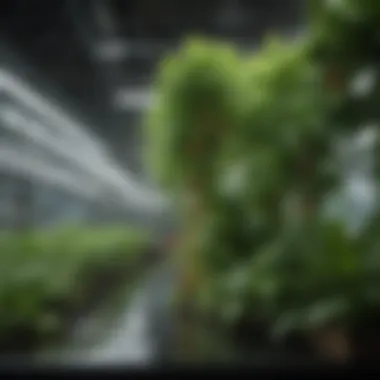
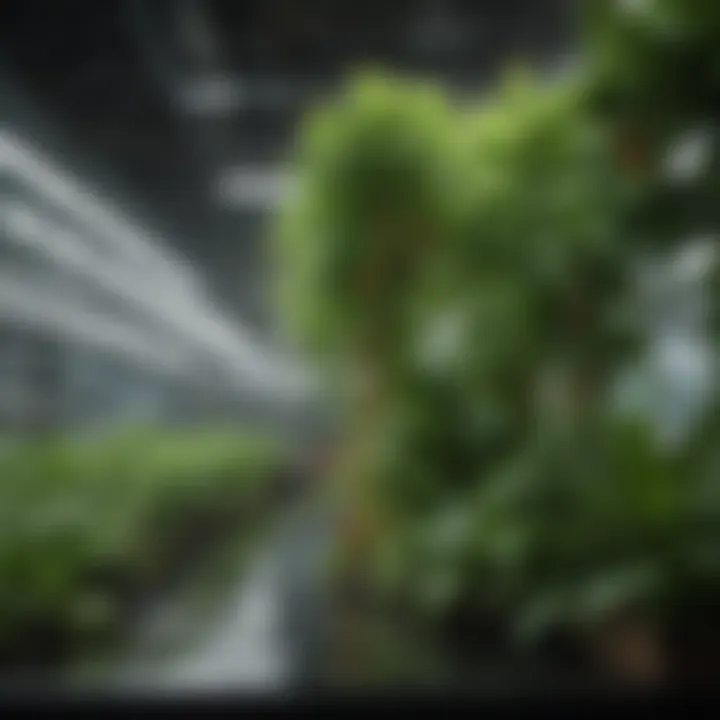
Intro
Hydroponic gardening has emerged as a transformative method of cultivation, attracting both novices and experienced gardeners alike. It has roots in the need for efficient, space-saving solutions in an era where traditional farming faces numerous challenges. In simple terms, hydroponics allows plants to grow without soil, using nutrient-rich water as their foundation. As the world shifts towards sustainability and food security, understanding hydroponic systems becomes paramount.
Topic Overview
Definition and Importance
Hydroponics refers to a method of growing plants in a water-based, nutrient-laden solution. This method not only conserves soil but also significantly reduces water usage, making it an efficient choice in arid regions. The importance of hydroponics lies in its ability to grow food in urban settings, alleviate pressure on farmland, and produce crops year-round regardless of climate. When approached correctly, hydroponics can offer a higher yield than traditional gardening methods—a vital aspect as the global population continues to rise.
Brief History and Evolution
The practice of hydroponic gardening isn't new; it has ancient roots. Historical texts suggest that the Hanging Gardens of Babylon, one of the Seven Wonders of the Ancient World, utilized soil-less techniques. Fast forward to the 20th century, hydroponics gained traction through the work of scientists like Dr. William Frederick Gericke, who famously coined the term. His experiments in the 1930s demonstrated that crops could be grown effectively without soil, laying the groundwork for modern hydroponics. Today, innovations in technology and a growing understanding of plant biology have spurred a renaissance in this field.
Key Techniques and Innovations
Sustainable Farming Practices
Sustainable practices are at the heart of modern hydroponic systems. They involve using renewable resources, reducing waste, and minimizing the carbon footprint. Some notable methods include:
- Closed-loop systems: These recirculate water and nutrients, drastically reducing waste.
- Vertical farming: Stacks of plants maximize space and light usage.
- LED grow lights: These energy-efficient lights mimic sunlight, promoting growth while saving energy.
Advanced Agronomic Technologies
The landscape of hydroponic gardening continues to evolve, thanks to advancements in technology. Precision agriculture technologies, such as sensors and data analytics, are now integrated into hydroponic setups. These tools help in monitoring plant health, nutrient levels, and water usage, providing growers with real-time data to make informed decisions. Additionally, automation in climate control ensures optimal growing conditions, allowing for greater consistency in crop production.
Practical Applications
Step-by-Step Guides
Starting a hydroponic garden can be broken down into a few fundamental steps:
- Choose Your Hydroponic System: There are several systems to select from, like Deep Water Culture, Nutrient Film Technique, or Aeroponics. Each has its benefits depending on your available space and desired crops.
- Gather Materials: Essential materials include a reservoir for water, net pots for plant support, grow lights if natural light is limited, and nutrient solutions.
- Plant Your Seeds: Start with seeds or seedlings, ensuring they're healthy before introducing them to the hydroponic setup.
- Maintain Temperature and Nutrients: Keeping track of the water temperature and nutrient concentration is vital for optimal growth.
Case Studies or Real-World Examples
Consider the case of urban areas like Brooklyn, New York, where hydroponic farms like AeroFarms have transformed derelict buildings into green spaces producing fresh produce. They utilize vertical farming techniques to maximize the use of limited space, catering directly to local markets. Their approach of combining cutting-edge technology with sustainable practices showcases the vast potential of hydroponics, aligning with the needs of today’s agricultural landscape.
"Hydroponics is more than just a method of growing; it's a lifestyle choice that promotes sustainability and efficiency."
In an ever-changing world, hydroponic gardening offers promising solutions to food production challenges. As we venture further into this guide, readers will find detailed discussions on system types, their respective pros and cons, as well as guidance on overcoming common challenges faced in hydroponic gardening. By the end, the aim is not just to inform but to equip readers with practical insights to unleash their inner hydroponic enthusiast.
Prelims to Hydroponic Gardening
Hydroponic gardening has gained substantial traction in recent years. As our world grapples with a growing population and dwindling agricultural land, this method of cultivation has emerged as a beacon of hope. The importance of hydroponics cannot be overstated, as it paves the way for innovative agricultural practices that require less space and resources. In this section, we will unravel key components and advantages of hydroponic gardening, setting a strong foundation for the subsequent exploration of various systems and techniques.
Definition of Hydroponics
At its core, hydroponics is the practice of growing plants without soil. Instead, plants are nourished through a water-based nutrient solution. This approach allows for precise control over the growing environment, enabling optimal conditions for plant health. For instance, crops like lettuce and basil flourish in these systems, demonstrating hydroponics' potential to produce high-quality yields. The term itself derives from Greek origins, translating to "water working." One could think of it as a symbiotic relationship between water and plants, where both parties thrive in a controlled setting.
History of Hydroponic Techniques
The roots of hydroponics trace back centuries. Ancient civilizations, such as the Aztecs, cultivated floating gardens on reed rafts, known as chinampas. These early iterations of hydroponics exemplify human ingenuity in utilizing available resources for agricultural endeavors. Fast forward to the 20th century, research conducted by scientists like Dr. Gericke and Dr. William Frederick Gericke further legitimized this technique. They introduced modern hydroponics to academic circles in the 1930s. The advent of technology in the late 20th century amplified the potential for urban farming, taking hydroponics to new heights.
Why Choose Hydroponics?
Opting for hydroponic gardening comes with a slew of benefits. Here are a few reasons why hydroponics stands out:
- Space Efficiency: Hydroponics can be practiced vertically, making it ideal for urban settings or areas with limited land.
- Water Conservation: This method can use up to 90% less water than traditional farming, which significantly benefits areas facing drought.
- Fewer Pesticides: A controlled environment typically has fewer pests, allowing for less reliance on chemical pesticides.
"Hydroponics is not just a method of gardening—it's a shift in how we think about and interact with our food."
With these advantages, it becomes clear why so many farmers and gardening enthusiasts are turning their attention to hydroponics. As we delve deeper into this guide, it will become increasingly apparent how various hydroponic systems can cater to different user needs and address common cultivation challenges.
Types of Hydroponic Systems
The world of hydroponics is diverse and innovative, offering a range of systems that cater to different needs, preferences, and available resources. Understanding the various types of hydroponic systems is crucial because this knowledge not only influences crop yield and growth but also impacts the efficiency and sustainability of urban agriculture practices. From the simplicity of wick systems to the advanced technology of aeroponics, each system presents its own unique set of benefits and challenges.
Nutrient Film Technique (NFT)
The Nutrient Film Technique, or NFT, is one of the foundational systems in hydroponics. Here, a thin film of nutrient-rich water continuously flows over the roots of the plants, providing them with both moisture and nutrients. This setup can be an excellent choice for fast-growing crops like lettuce and herbs which thrive in a nutrient-dense environment.
However, it is not without its drawbacks. The NFT system is highly sensitive to disruptions. If the water supply fails, the plants can quickly suffer from nutrient deprivation. Furthermore, the setup requires precise monitoring to maintain the right pH and nutrient levels, making it more suitable for those who have a basic understanding of hydroponics.
"NFT allows for efficient use of nutrients and minimizes water consumption, but careful calibration is key to avoid plant stress."
Deep Water Culture (DWC)
Deep Water Culture is another popular hydroponic system noted for its straightforward approach. In this method, plants are suspended in a solution of nutrient-rich water, their roots submerged and constantly oxygenated by air stones. This setup encourages strong root growth and rapid plant development, making it ideal for larger crops like tomatoes and peppers.
One of the significant advantages of DWC is its relatively low maintenance. Once established, the system requires minimal adjustments. Nonetheless, since the roots are always in water, ensuring proper oxygenation is critical. A lack of oxygen can quickly lead to root rot, a common pitfall for unsuspecting growers.
Aeroponics
Aeroponics stands apart from other hydroponic systems due to its reliance on mist rather than a nutrient solution in water. In an aeroponic setup, plant roots hang in the air, and nutrient droplets are sprayed directly onto them at regular intervals. This method maximizes oxygen exposure and minimizes water usage, which can be a game-changer in water-scarce regions.
Although it sounds high-tech, aeroponics does come with its challenges. The need for frequent monitoring of the misting schedule is essential to avoid drying out the roots. Additionally, failure in the misting system can wipe out an entire crop quickly. Still, for those willing to invest in the technology, the potential yield is impressive.


Ebb and Flow (Flood and Drain)
Ebb and Flow, commonly known as Flood and Drain, functions by periodically flooding the plant roots with nutrient solution and then allowing it to drain away. This cyclical approach creates an ideal combination of moisture and oxygen exposure, promoting healthy root development. It's versatile and can support various plants but requires careful timing in drainage cycles. Over or under-saturation can lead to problems; thus, experimenting with timing can be necessary for different crops.
Wick Systems
Wick systems are the most straightforward type of hydroponic system, where plants are grown in a medium that draws nutrient solution upwards through capillary action. While they are easy to set up and maintain, wick systems mainly suit smaller plants like herbs or seedlings. A major limitation is their reliance on gravity and the growing medium's moisture retention capacity—larger plants that require abundant water might not flourish as easily in this setup.
Drip Systems
Drip systems offer a balanced approach, combining the elements of efficiency and adaptability. In this setup, a network of tubes delivers a slow, constant supply of nutrient solution directly to the plants' roots. This method prevents overwatering while ensuring that each plant receives an adequate dose of nutrients.
While drip systems are recognized for their scalability and suitability for commercial applications, they may require regular maintenance to avoid clogging and blockages, especially if using organic substrates.
Evaluating Hydroponic Garden Kits
In an era where growing our own food is becoming more of a necessity than a luxury, understanding how to choose the right hydroponic garden kit is essential. Evaluating these kits involves examining various aspects such as functionality, suitability for our type of gardening, and the benefits they provide. For both seasoned growers and novices alike, selecting a hydroponic system that fits personal needs can enhance the experience and increase yield potential.
Key Features to Consider
When looking at different hydroponic garden kits, several important features must be taken into consideration:
- System Type: Different kits come with their own methods like NFT or DWC. It's crucial to understand which system aligns with your gardening goals.
- Size and Scale: The dimensions of the kit should match your available space—whether that's a small balcony or a spacious indoor setup.
- Ease of Setup: Kits vary in complexity. Some are designed for immediate use, while others might require an assembly that could take some time.
- Material Quality: Look for systems made of durable materials that can withstand wear and tear, especially for outdoor systems exposed to the elements.
"Not every garden deserves the same tools; choosing with care can bloom success like nothing else."
Care and Maintenance Needs
It's vital to consider how much time and effort you’re willing to invest after setting up your hydroponic system. Proper maintenance ensures the longevity and productivity of your garden:
- Regular Monitoring: Most hydroponic systems require consistent checks of nutrient levels, pH balance, and water temperature.
- Cleaning Protocols: Algae and bacteria can thrive in nutrient solutions. Regular flushing and cleaning of the system can prevent these issues.
- Replacement Parts: Some systems may need parts replaced over time, such as pumps or grow lights. Checking the availability and cost of these parts is vital before making a purchase.
- Pest Control Strategies: While hydroponics reduces many pests common in soil gardening, keeping an eye on potential issues is still necessary. Knowing what treatments, if any, are compatible with your chosen system is beneficial.
Cost Analysis of Hydroponic Systems
Investing in a hydroponic garden can range from very affordable to quite pricey, depending on the features, scalability, and complexity of the system. When evaluating costs, consider these factors:
- Initial Cost vs. Long-Term Investment: While some systems might seem expensive upfront, they may provide better yield and lower recurrent costs over time.
- Operational Costs: Assess costs for nutrients, water, and energy, especially in systems that require significant lighting.
- Potential Savings: Think about how much you could save in groceries if you grow your own produce. The return on investment can be significantly high if managed well.
Advantages of Hydroponic Gardening
Hydroponic gardening, where plants grow in nutrient-rich water instead of traditional soil, is not just a trend—it's a game-changer for agriculture and home gardening alike. With a range of benefits that cater to both urban environments and sustainable farming practices, these systems are getting plenty of attention. Understanding the various advantages associated with hydroponic gardening can help gardeners at any level make informed decisions about their growing methods.
Increased Crop Yields
One primary allure of hydroponic systems is the potential for significantly increased crop yields. This spike in productivity can often outstrip traditional soil-based gardening. The plants receive direct access to nutrients, thereby facilitating faster growth cycles. Take, for example, a grower cultivating lettuce in a hydroponic setup. While it may take about 30 to 45 days in soil, in a hydroponic environment, that time can be shortened to merely 21 days.
Such efficiencies can be attributed to:
- Controlled Nutrient Availability: Nutrient solutions can be tailored to meet the specific needs of different plants at various growth stages.
- Disease Reduction: Without soil, the risk of soil-borne diseases diminishes, allowing for healthier plants.
- Optimized Conditions: Growers can fine-tune environmental conditions, pushing yields even higher.
In essence, hydroponics operates like a well-oiled machine, reducing the time from seed to harvest while allowing for continuous cropping.
Water Efficiency
Water management is another significant advantage of hydroponic gardening. Traditional farming is water-heavy, often wasting precious resources through evaporation and runoff. Hydroponic systems, however, can be strikingly efficient. This is because:
- Recirculation: Many hydroponic systems recycle water, directing excess back into the nutrient reservoir. This can save up to 90% more water compared to traditional farming practices.
- Evaporation Control: With controlled environments, water loss through evaporation is minimized, especially in fully enclosed systems like aeroponics and vertical farms.
Hydroponics emerges as a solution to address growing concerns surrounding water scarcity while still meeting global food demands. Reducing water waste is not just an advantage; it is a necessity in many regions of the world where water is under immense pressure.
Space-Saving Techniques
Another noteworthy advantage is the ability to maximize space. Hydroponic systems can be stacked vertically, fitting into areas where traditional farming wouldn’t stand a chance. This facet is particularly beneficial in urban settings where square footage is a premium. The concepts include:
- Vertical Farming Systems: Structures can be designed to house multiple layers of growth, leading to higher outputs per square foot.
- Modular Units: Many hydroponic kits are designed to fit snugly in small spaces, making them suitable for balconies, rooftops, or even indoor basements.
"Space constraints no longer limit your ability to grow fresh food; hydroponics brings the farm to your home."
In summation, hydroponics not only transforms how we approach the growing of food but also embodies a forward-thinking model that addresses pressing agricultural challenges. A careful evaluation of these advantages provides a roadmap for both seasoned farmers and enthusiastic hobbyists looking to dive deeper into sustainable practices.
Challenges in Hydroponic Gardening
In the realm of hydroponic gardening, challenges are par for the course. Despite its clear advantages over traditional soil gardening, such as water efficiency and space-saving capabilities, hydroponics isn’t a walk in the park. Understanding these challenges helps in mitigating risks and ensuring a fruitful yield. Key issues span pest management, nutrient imbalances, and the high-stakes nature of system failures.
Pest Management in Controlled Environments
When you step into a hydroponic setup, you might think pests are a thing of the past. After all, you're not dealing with soil, right? Wrong. Just like any other garden, pests can sneak in. They often find their way into the nutrient solutions or within the confines of your system.
Managing pests in a hydroponic garden requires a tailored approach. Here are some effective strategies:
- Regular monitoring: Being proactive is the name of the game. Regularly check plants, particularly the undersides of leaves, where pests tend to hide.
- Beneficial insects: Introducing predators like ladybugs or predatory mites can help control pest populations. They can act like your garden's very own security force.
- Proper sanitation: Keeping your environment clean is critical. Disinfect tools after each use and ensure that entry points to your garden are secure to prevent unwanted guests.
Effective pest management not only protects your plants but also contributes to healthier crop yields over time.
Nutrient Imbalances
Hydroponics thrives on precision, but maintaining the right nutrient balance can become a tricky balancing act. Different plants have varying requirements; neglecting these can lead to nutrient deficiencies or toxicities. Signs might manifest as discoloration, stunted growth, or poor yields.
To tackle nutrient imbalances, consider:
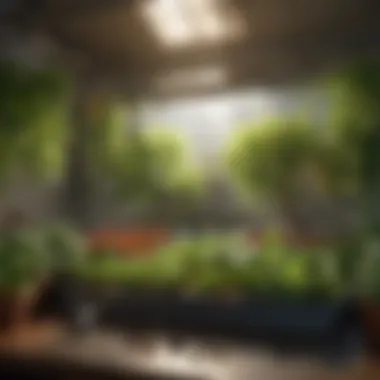

- Regular testing: Regularly check your nutrient solution using testing kits. It’s akin to taking a pulse on your plants' health.
- Using quality products: Invest in high-quality nutrient solutions designed for hydroponic systems. Cheaper options often lead to problems down the line.
- Adapting to plant stages: Nutritional needs will change as plants mature. Seedlings won’t require as much as fully grown plants do, so adjust your nutrient mix accordingly.
System Failures and Their Implications
Nothing can be more disheartening than coming out to your hydroponic garden, only to find a system failure. Small glitches in technology can lead to significant consequences. A pump failure can quickly drown plants or deprive them of vital nutrients.
To minimize system failures, keep the following in mind:
- Regular maintenance: Regularly inspect your system components—pumps, timers, and maintain those hoses. Slight problems, if unchecked, can snowball.
- Backup plans: Consider installing backup systems or alerts that notify you of any failures. They can act as early warning systems, helping you to act before it’s too late.
- Educate yourself: Take your time to understand how each part of your system works. Knowledge can help troubleshoot issues when they arise.
In summation, understanding these challenges is key to achieving success in hydroponic gardening. Familiarity with pest management, keeping tabs on nutrient levels, and ensuring system reliability make navigating the hurdles much more manageable. By equipping yourself with this knowledge, you’ll be well on your way to cultivating a successful hydroponic garden.
Optimizing Growth Conditions
In the realm of hydroponics, achieving a harmonious balance of various environmental factors is paramount. Optimizing growth conditions can be the bedrock of a successful hydroponic garden, influencing not only the health of plants but also their growth rates and yields. Misalignment in conditions, however minor, can lead to stress in plants, ultimately jeopardizing the entire operation. Knowing how to manipulate light, temperature, humidity, and oxygen levels is crucial. It’s like tuning a finely crafted instrument: when everything is in sync, the results can be spectacular.
Light Requirements for Hydroponics
Light is a keystone in the growth of any plant, and hydroponics is no exception. The type, intensity, and duration of light have direct consequences on plant development. Plants utilize light for photosynthesis, transforming carbon dioxide and water into the energy needed to thrive.
- Type of Light: Not all lights are created equal. LED lights have become increasingly popular in hydroponic gardening due to their energy efficiency and spectrum flexibility. Fluorescent lights may also be used, but they often lack the intensity needed for larger yields.
- Intensity: The level of light intensity needs to be tailored to the specific plants being grown. For instance, leafy greens like kale tend to require less intense light than fruiting plants such as tomatoes.
- Duration: The length of time plants are exposed to light, known as photoperiod, is another element that shouldn't be overlooked. Many plants thrive with 12-16 hours of light per day, but certain flowering varieties have specific needs that should be met to encourage blooming.
A solid rule of thumb is to observe the growth patterns. If plants are stretching toward the light or exhibiting pale leaves, it might be time to reassess your lighting setup. Therefore, a keen eye can often guide corrective measures before major issues arise.
Temperature and Humidity Control
Maintaining optimal temperature and humidity levels in a hydroponic garden is akin to maintaining a cozy atmosphere in your home—too hot or too cold, and it can become uncomfortable.
Heat tolerance varies among plants, but generally, most thrive in a temperature range of 65 to 80 degrees Fahrenheit during the day, dropping slightly at night. Humidity, on the other hand, is a bit trickier. High humidity can lead to fungal diseases, while low humidity may stifle growth.
- Temperature Management: Installing thermostats and heaters or coolers can help maintain consistent temperatures. Certain hydroponic systems even come equipped with temperature regulation features, which can be quite handy.
- Humidity Control: Using a hygrometer to monitor humidity levels helps in making informed adjustments. When humidity levels dip too low, misting plants may provide temporary relief. Alternatively, increasing air circulation can mitigate high humidity levels.
As conditions drift from the ideal range, plants could exhibit signs of stress, manifesting as wilting or yellowing leaves. Monitoring these variables closely is vital to keep everything in check.
Oxygenation of Nutrient Solutions
If plants are the body in a hydroponic setup, then nutrient solutions serve as their lifeblood. Just as we need oxygen to thrive, plants require properly oxygenated nutrient solutions to absorb nutrients effectively.
Oxygenation is critical because it prevents root rot, promotes healthy root development, and encourages nutrient uptake.
- Aeration Techniques: Adding air pumps and diffusers to your nutrient reservoir can significantly enhance oxygen levels. Ensuring that the roots have access to a steady supply of oxygen could mean the difference between a robust plant and one that struggles.
- Monitoring Nutrient Solutions: Regularly checking the dissolved oxygen levels in nutrient solutions is advisable. A good measure is keeping oxygen levels between 6-8 mg/L.
Having good oxygenation practices allows roots to grow healthy and strong, which in turn leads to more vigorous plant growth. Careful observation can make a world of difference—for example, cloudy water or root discoloration are red flags.
"In hydroponics, the right conditions transform plants into vibrant life sources, not just mere sustenance."
In summary, regardless of the hydroponic system used, consistently optimizing growth conditions by managing light, temperature, humidity, and oxygenation of nutrient solutions can dramatically improve the performance of the garden. Keeping an eye on these factors will pay dividends in terms of plant health and yield. By nurturing these essential aspects, you can ensure your hydroponic garden becomes a thriving ecosystem.
Technology in Hydroponics
As we venture into the realm of hydroponics, one cannot overlook the pivotal role technology plays in this field. Hydroponics, at its core, simplifies traditional gardening practices by eliminating soil and instead utilizing nutrient-rich water solutions. Yet, just like any modern agricultural method, the incorporation of technology transforms and elevates the efficiency and effectiveness of this approach. From systems that automate routines to sensors that monitor growth conditions, technology delivers a plethora of benefits which are essential for anyone looking to maximize their hydroponic ventures.
Automation and Monitoring Tools
Automation has revolutionized many aspects of farming, and hydroponics is no exception. With devices that can regulate light, temperature, and nutrient delivery based on real-time data, growers can ensure that plants receive optimal conditions without the tedious manual labor.
- Automated systems can manage light cycles without requiring constant supervision from the gardener. This ensures plants receive the right amount of light, mimicking natural conditions but on a schedule that accelerates growth.
- Monitoring tools provide alerts for any anomalies, ensuring that issues such as nutrient imbalances or equipment malfunctions are addressed before they affect crop yield.
"Embracing automation frees up a gardener's time while ensuring a precise focus on the plants' needs, akin to having a personal assistant who understands every facet of hydroponic care."
Nutrient Delivery Systems
At the heart of successful hydroponic gardening lies the nutrient delivery system. The right balance of nutrients is crucial for plant health. Various systems are designed to cater to specific plant needs. Methods such as drip irrigation and nutrient film technique can provide tailored nutrient solutions, allowing for flexibility based on plant growth stages.
- Drip systems deliver nutrients at a slow and measured rate, ensuring that plants absorb exactly what they need.
- Nutrient film techniques, on the other hand, circulate nutrients over the roots which allows for enhanced oxygenation and nutrient uptake.
Consideration of how these systems integrate with technology is essential; the greater the automation in nutrient delivery, the less chance of human error and the more consistent the results.
Adoption of Smart Sensors
In today’s hydroponic setups, smart sensors stand out as an indispensable addition. These devices can offer continuous feedback, helping growers to refine their methods and respond to plant needs instantly.
- pH and EC sensors monitor nutrient solution properties. This allows for timely adjustments, avoiding nutrient deficiencies or toxicities that can hinder growth.
- Temperature and humidity sensors ensure that the environmental conditions remain ideal, safeguarding the overall health of the plants.
The data collected by these sensors can be viewed in real-time, often through mobile applications, making it easier for enthusiasts and professionals alike to manage their setups effectively.
To sum it up, the integration of technology in hydroponics significantly elevates the practice. As hydroponics continues to thrive and evolve, incorporating these advancements not only enhances productivity but also enriches the overall gardening experience. Those who embrace these technological innovations are set to enjoy sustainable growth and bountiful harvests.
Sustainability in Hydroponics
Sustainability in hydroponics is more than just a buzzword; it’s a necessity in today’s rapidly changing environment. As we face challenges posed by climate change, resource depletion, and the quest for food security, adopting sustainable hydroponic practices isn't just advantageous, it’s crucial. Hydroponics, as a method of soil-less farming, has the potential to significantly reduce reliance on land and water resources, which have been stretched thin due to traditional agriculture.
By utilizing hydroponic systems, growers can dramatically minimize their carbon footprint, while maximizing productivity—even in urban settings. The intersection of sustainability and hydroponics offers a promising avenue for addressing some of the pressing questions about future food systems. Let’s delve into the specific ways hydroponics contributes to a greener planet.
Reducing Carbon Footprint
The carbon footprint associated with food production is staggering, with transportation, land preparation, and fertilizer use adding up quickly. With hydroponics, we take a step back and view this from a different lens.
- Local Production: Hydroponics allows for the growth of food right where it's needed, significantly reducing transportation emissions. Imagine fresh basil grown on your balcony instead of transported from the countryside.
- Energy Efficiency: Many hydroponic systems are designed to be energy-efficient. By using LED grow lights and automated nutrient delivery systems, growers can minimize energy waste. This use of energy-efficient technology is key to making hydroponics a greener option.
- Less Waste: Hydroponics contributes to reduced land degradation and deforestation. The ever-expanding need for arable land translates to ecosystem disruptions. Hydroponic farms can be set up vertically, utilizing urban space that would otherwise go to waste.
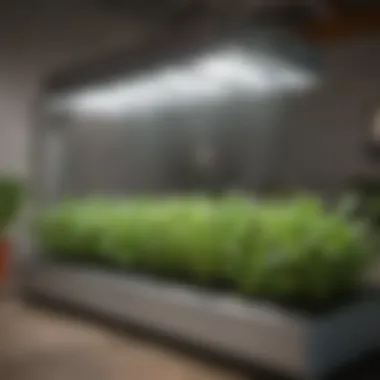
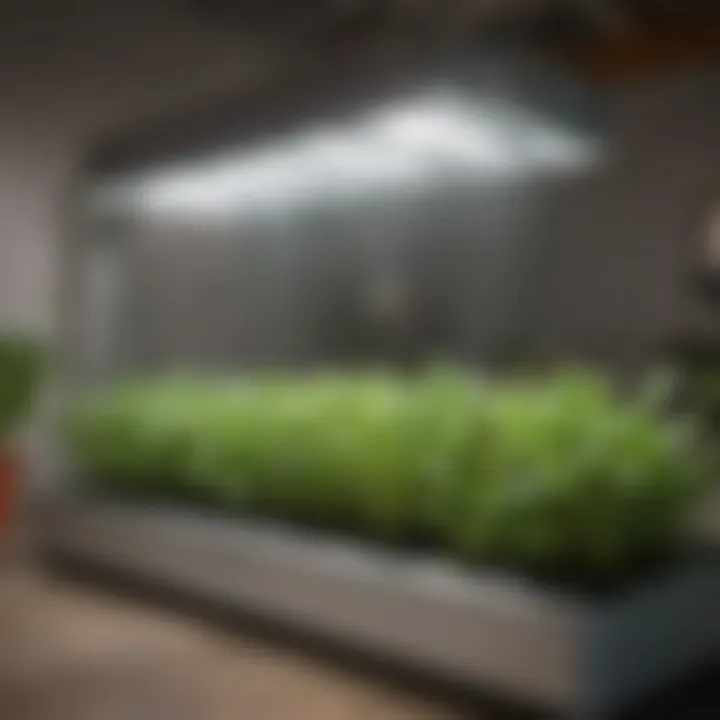
"The future of agriculture lies in the fusion of technology and nature, enabling us to cultivate with care for our planet."
Integration with Urban Agriculture
Urban agriculture is more than a trend; it’s a lifeline for metropolitan communities. Hydroponics fits seamlessly into the urban landscape, bringing an innovative solution to food deserts.
- Space Utilization: Many cities are characterized by limited space. Hydroponic systems can easily be integrated into rooftops, empty buildings, and even community gardens. This practice revitalizes neglected areas while supplying fresh produce.
- Community Involvement: Involving local communities in hydroponic gardening initiatives fosters connections and encourages citizens to take charge of their food sources. Workshops and classes can translate into a shared knowledge base that benefits all involved.
- Reducing Transport Needs: Growing food locally means reducing the need for long-distance transportation. This leads to fresher produce for residents and lowers greenhouse gas emissions.
Contribution to Eco-Friendly Practices
The pursuit of sustainable farming practices aligns closely with eco-friendly initiatives, and hydroponics shines in this arena. Here’s how:
- Resource Efficiency: Hydroponics uses significantly less water than traditional methods, as it recirculates water rather than consuming it. This closed-loop system allows for responsible water use, a crucial consideration in areas facing water scarcity.
- Pesticide Reduction: Hydroponic systems often experience fewer pest-related issues. Consequently, this can lead to a reduction in pesticide usage, allowing for the cultivation of cleaner produce.
- Soil Preservation: Since soil is not used, hydroponics helps in conserving valuable soil resources and protects them from erosion and degradation. This contributes positively to biodiversity and ecosystem health.
Selecting the Right Hydroponic System
Choosing the right hydroponic system is not as simple as picking flowers at a roadside stand. It involves examining myriad details, from your individual living space to the type of plants you want to grow, as well as your resource availability. Getting this part right can lay the groundwork for a flourishing hydroponic garden, whereas a poor choice can lead to a garden more beleaguered than bountiful. By investing some time into understanding what each system can offer and aligning those features with your personal desires and limitations, you can set yourself up for success in this innovative method of gardening.
Assessing Your Space and Resources
The first step in choosing the ideal hydroponic system is to take a good hard look at the space you have available. Consider factors like:
- Size: Are you working with an intimate nook in your apartment, or do you have a sprawling basement ready for transformation?
- Light Exposure: Is the area brimming with natural sunlight, or will you lean heavily on artificial lights?
- Access to Water and Power: Can you easily set up a water source and electrical outlets nearby for your equipment?
Assessing your space isn’t just about dimensions; it’s about understanding its capabilities and limitations. A system that thrives in a compact area may not be suitable for an expansive workshop. For instance, a vertical system often suits smaller spaces, stacking plants upward, while deep water culture systems may require more horizontal space to function efficiently. Remember: the best garden is one that fits harmoniously into its environment.
Understanding Plant Selection Criteria
The choice of plants you aim to grow can significantly impact the hydroponic system you need. Different plants thrive under various conditions, which could influence the type of setup you’ll opt for. Consider the following:
- Growth Habits: Leafy greens like lettuce flourish in NFT systems, while tomatoes may prefer the more substantial support of a drip system.
- Root Structure: Plants with shallow roots might do well in systems with limited water depth, while those with deeper roots will necessitate a system that supports adequate nutrient solution.
- Light Requirements: Understand whether your chosen plants need full sun or can be content with partial shade. This can dictate the choice of your lighting systems.
By grasping these nuances in plant behavior and needs, you’ll be selecting not just a hydroponic system, but rather a customized environment that meets the demands of your green companions.
Identifying Personal Goals and Preferences
Next comes the most subjective mission: identifying your own goals and preferences in hydroponics. What do you want to achieve? Are you aiming for an abundance of fresh vegetables, or is it more about the joy of gardening? Determining your objectives helps shape your decisions. Some questions to ponder include:
- Are you intent on maximizing yield? If so, perhaps consider vertical farms that utilize space efficiently.
- Are time and effort a concern? Systems like Ebb and Flow can be easier to manage amidst a busy schedule.
- Do you wish to experiment with unique plants? Certain systems allow for greater diversity of crops, offering the thrill of variety.
Ultimately, your personal connection to the process, along with your desired outcomes, will guide you towards the hydroponic system that feels right. Remember: each decision fosters a unique experience, turning your space into not just a garden, but a reflection of your choices, aspirations, and dedication to soil-less gardening.
"Selecting the right hydroponic system is like tailoring a suit — it needs to fit your unique shape and preferences to feel just right."
Future Trends in Hydroponics
The fast-paced evolution of hydroponics is shaping the future of agriculture. With the increasing demand for sustainable food production methods, understanding these emerging trends is paramount for anyone interested in soil-less gardening. The future is not just about better yields; it's about using innovative methods to grow food with minimal impact on the environment.
Vertical Farming Innovations
Vertical farming stands at the forefront of hydroponics, utilizing an upward growing technique that saves space in urban settings. Imagine a tall building or a repurposed warehouse full of leafy greens instead of concrete and steel. This method involves stackable trays and advanced lighting systems that mimic sunlight, providing plants optimal growth conditions. With urban areas growing, vertical farming offers a solution to the limited land resources.
The benefits go beyond just aesthetics. By utilizing vertical space, farmers can increase crop production per square foot significantly. Additionally, vertical farms typically use less water and fewer pesticides, which align with eco-conscious practices. Advanced technologies such as hydroponic systems integrated into vertical farms allow for more controlled environments, resulting in quicker harvests at minimal labor costs.
Advancements in Plant Genetics
The science of genetics is another key player in the future of hydroponics. As more research unfolds, we’re seeing the development of genetically modified plants with traits that enhance their performance in hydroponic systems. These improvements include increased resistance to diseases, enhanced yield potential, and the ability to thrive in less-than-ideal conditions.
For instance, scientists are working on varieties of tomatoes and basil that grow faster and require less nutrition than their traditional counterparts. Such advancements ensure that hydroponic gardens can yield produce in a shorter span, making the whole endeavor economically viable for larger operations. It’s like having a secret weapon in the garden—you gain bounty faster without compromising quality.
Expanding Market Opportunities
Hydroponics isn't just a trend; it's creating new market opportunities for business-minded individuals. The growing interest means that ventures in hydroponic technology, equipment, and supplies are booming. Unofficially, there’s a gold rush for anyone who can pull the right strings—be it retailers or tech enthusiasts wanting to dive into the agricultural tech field.
Businesses centered around hydroponic systems can range from DIY kits for home gardeners to large scale solutions for grocery chains wanting fresh produce directly from the source. The rise in consumer demand for local and sustainable produce is driving companies to invest heavily in hydroponic setups. Dive deeper into these opportunities:
- Retail: Local markets are beginning to source more hydroponically grown produce, tapping into health-conscious consumers.
- Food Distribution: Establishments are looking into partnerships with hydroponic farms to provide fresher options.
- Educational Resources: With many schools jumping into sustainable agriculture programs, there’s a market for educational hydroponic systems.
The combination of technological advancements and changing consumer habits positions hydroponics not only as an agricultural solution but as a viable business model.
"The opportunities in hydroponics extend far beyond the garden; they touch every aspect of modern living."
In summary, the trends within hydroponics indicate growth not only in farming techniques and plant robustness but also open up fresh avenues for market engagement. Keeping an ear to the ground in this rapidly advancing field is beneficial for anyone looking to either participate or innovate in hydroponic gardening.
Closure
In wrapping up our exploration of hydroponic gardening, we highlight how pivotal this subject is in today's agricultural dialogue. The journey through the myriad types of hydroponic systems, their distinct advantages and challenges, and the integration of technology showcases just how versatile and innovative soil-less gardening can be. As we face issues like urban overcrowding and environmental concerns, hydroponics stands out as a resilient alternative.
The benefits of adopting hydroponic techniques are compelling. Increased crop yields and the efficient use of limited water resources can transform urban agriculture. It’s important to understand that, while this method is not without its hurdles—like pest management and nutrient balance—the rewards are often worthwhile. Many growers find the minimized space requirements a game-changer, allowing productive cultivation in previously unusable areas. Such insights are essential for anyone contemplating this dynamic approach to gardening.
Summarizing Key Insights
From our discussion, it's evident that hydroponic systems offer diverse options to suit various needs. Here are some key points to take away:
- Understanding Systems: Knowledge of systems like NFT, DWC, and aeroponics equips potential gardeners to select based on resource availability and personal preferences.
- Sustainability: Hydroponics not only enhances crop growth but also contributes to sustainable practices that align with eco-friendly goals.
- Technological Integration: The role of technology in monitoring and optimizing growth conditions cannot be overstated—it’s a stepping stone to better productivity in urban settings.
Ultimately, the conclusion resonates with all aspects covered in this guide. Hydroponics is not just a trend; it’s a substantial and practical alternative worth considering for the future of food production.
Encouraging Further Exploration
There’s a wealth of knowledge still to discover in the transitioning field of hydroponics. For those intrigued by the possibilities, engaging with communities on platforms like Reddit or Facebook can provide real-world insights and experiences that enhance understanding.
- Join Forums: Participating in discussions can reveal personal stories that may help clarify doubts or uncertainties about starting your own hydroponic garden.
- Research Further: Reading academic articles or recent studies can open doors to innovative techniques and evolving practices that are on the horizon.
- Experiment: If you’re motivated, nothing beats getting your hands dirty. Start small with a DIY hydroponic system to familiarize yourself with the nuances of soil-less gardening.
In summary, hydroponics represents a frontier worth probing into. As urban garden enthusiasts or seasoned farmers, there’s always something new to learn and opportunities waiting to be seized in this exciting agricultural movement.



